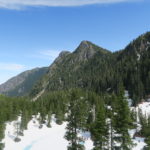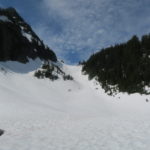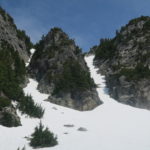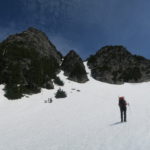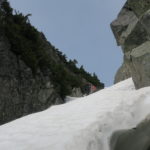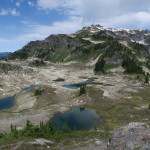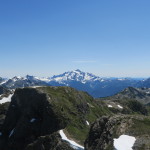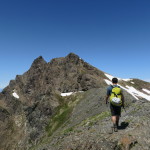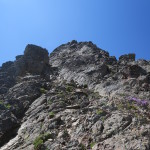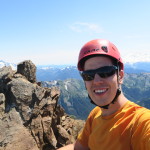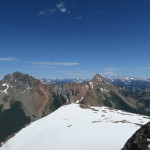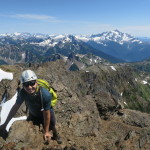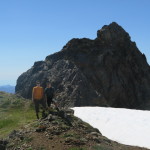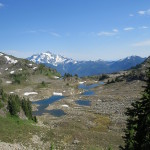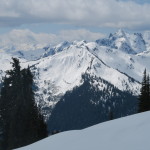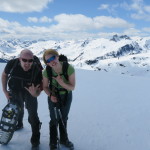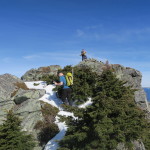Blackcomb Buttress
Date: Sept 15, 2016
Participants: Brittany Zenger, Geoff Zenger, Ross Berg (guide)
Difficulty: 5.4
Report: Years ago I was promised as part of a birthday gift that Brittany and I would climb Blackcomb Buttress, but life happened and those plans fell by the wayside. Then just earlier this week Brittany found out that she could take Thursday off work, and with the weather forecast looking gorgeous the idea came back to climb the Buttress. There was only one complication: Brittany hadn’t been on rock since a couple months after she became pregnant and going alpine climbing by ourselves for her first rock experience in well over a year didn’t seem like a great idea. Luckily for us, a friend recommended that we talk to Ross at Altus Mountain Guides and we were fortunate to find that he was free to guide us that day.
We all met at the base of the Whistler gondola just before the lift opened at 10, and after a quick gear check, we rode the gondola up and then took the peak 2 peak over to Blackcomb, arriving on Blackcomb just before 11. It was a short 30 or 40 minute hike over to Lakeside Bowl, where we ate a snack, sorted out a bit more gear, and started making our way up below DOA towards the Buttress. From below it looks like you’d have to go through some steep loose terrain to reach the Buttress, but by wandering left and right of the main gully it was possible to ascend to the base of the climb on reasonably solid rock for the most part, and reached the base of the route a bit before 1pm.
As an aside, although the forecast that morning had been for sun, the alpine high had been forecast to be around 8 or 9 degrees and I had chosen to wear a long sleeved shirt. In reality however, the alpine temperature hovered around 20 degrees and with no breeze to speak of I was hot all day. That said, I can’t really complain about a beautiful warm alpine day in mid September!
After another snack and gearing up to go, it was time to climb! We chose to climb the main rib of the lower buttress (not the optional left rib mentioned in Alpine Select). The route started out steeper than I expected. Just a couple weeks earlier I’d climbed Pigeon Spire’s West Ridge, which like the Blackcomb Buttress is also rated at PD (5.4), but comparing the two routes shows how neither the YDS or Alpine grade can fully capture the character of a route. Whereas Pigeon was essentially a long super-exposed scramble above glaciers, almost entirely at very moderate angle, Blackcomb Buttress is a much shorter, steeper, and significantly less exposed. Also for comparison, while Blackcomb Buttress seemed quite stable and very few rocks were moving on us, it is still quite fractured terrain whereas Pigeon is almost Squamish quality granite.
The first rope length was quite steep and due to Brittany being approximately 20m ahead of me on the same rope and out of sight from me, it felt a lot like free soloing with a rope only for catastrophe prevention. That said, the moves themselves were easy, and higher up the angle kicks back as the route wanders up through blocky terrain with generous belay ledges to be found whenever needed. We climbed the route in 5 or 6 pitches, and about 90 minutes from when we started were on the summit of Blackcomb Mountain. The weather was perfect, as were the views. It had been many years since I’d been on Blackcomb in the summer and it was great to see a summer view of the Spearhead range from that side of the valley, in addition to the great views of the Tantalus group, Cayley group, and Mt. James Turner area.
Following an extended summit lunch break, we set off at about 3pm to head first towards Decker, then down body bag bowl and around Blackcomb back to Lakeside bowl where we would regain the trail system. At this time of year, the last gondola ride back to Whistler departs at 5:15 and so we had no time to dawdle. It took us about an hour and a half to work down the talus fields to the trails, but with a bit of hustle in our step it was only 30 minutes from there back to the peak 2 peak gondola, which we reached with 10 minutes to spare! Total gondola to gondola round trip time was just a few minutes over 6 hours. Without a doubt this was the shortest round trip time I’ve ever had for an alpine climb.
In all, this was a fantastic day out in the mountains. I’m super happy to have made it out alpine climbing with Brittany this year and to have found a very enjoyable route to boot. This was certainly my least stressful alpine climbing day ever. Many thanks as well to Ross for coming out with us, showing us the way and keeping us safe.






























